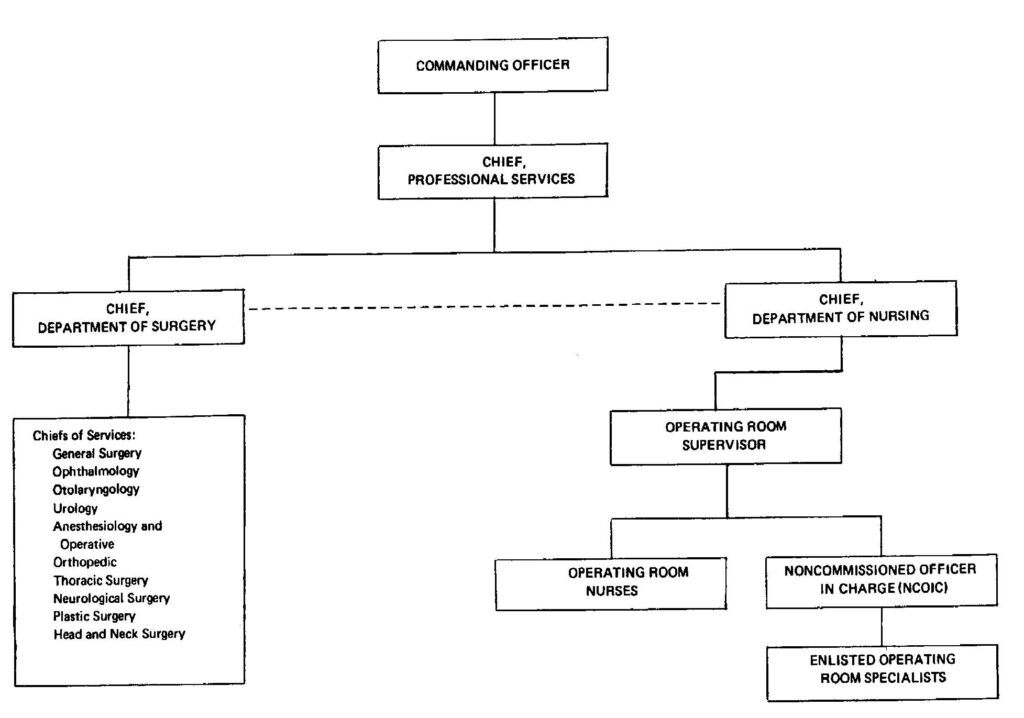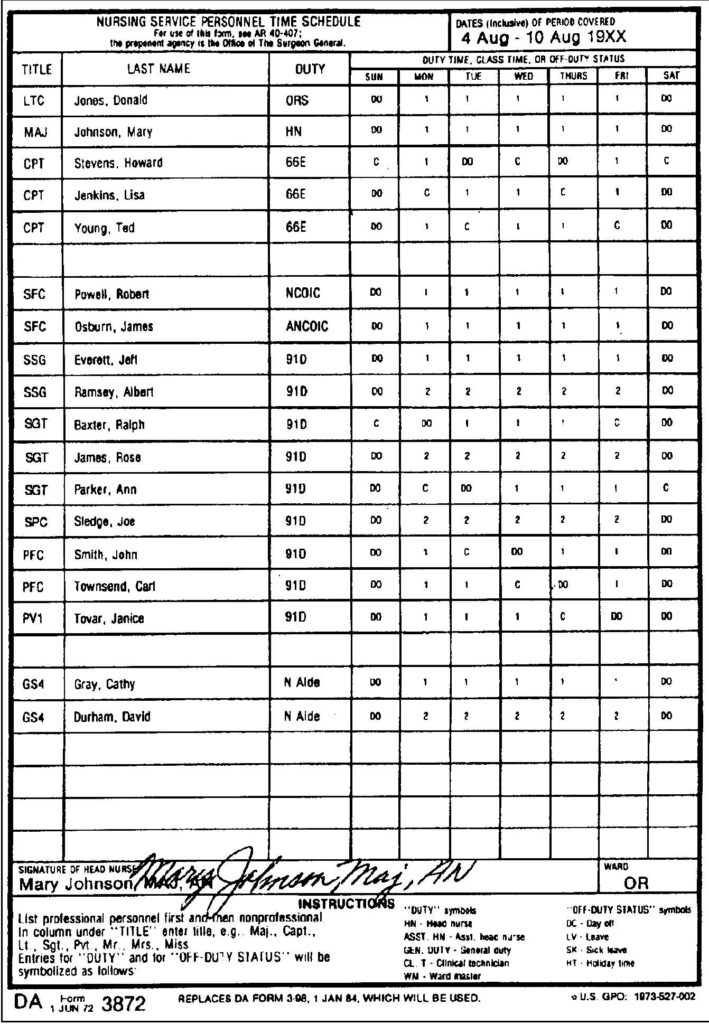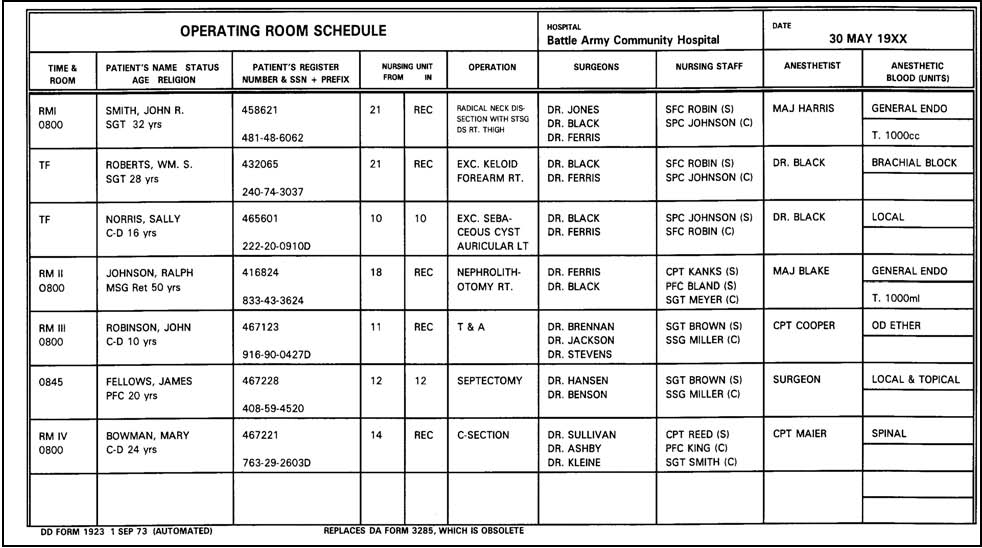2-12. INTRODUCTION
a. Discussion.
(1) The operating room team consists of all members of the OR staff. As an example, the team includes the OR specialist who usually performs the patient’s skin preparation the day before surgery, the specialist who put up the packs that are used for the operation, the specialist (or the AN Officer) who selects the set of instruments, and the specialist who sterilizes the supplies used for the surgery. Other team members who may not necessarily be in an OR during an operation are the Chief of Department of Surgery, the Chief of Anesthesiology and Operative Services, the OR Supervisor, and the noncommissioned officer In charge (NCOIC).
The surgical team is the group of people in the immediate area during a surgical procedure. This includes the surgeon and one or more assistants (depending on the complexity of the case), the anesthetist, the nurse or specialist performing the scrub duties, and the nurse or specialist performing circulating duties. All team members work together to accomplish the best possible care of the patient. Every job performed in the OR–no matter how small–contributes to the welfare of the patient, and no job is so important that it alone accounts for the recovery of the patient.
(2) Knowledge of the nature of the duties of OR team members as well as their relationships with each other is essential to the OR specialist because without such knowledge he cannot fully appreciate what is required of him. Figure 2-1 indicates the line of authority for the or. NOTE: The hospital commander, the chief of professional services, and the chief, department of nursing are not considered members of the OR team.

b. Professional and Nonprofessional Team Members.
(1) The professional members of the team include Medical Corps (MC) Officers and Army Nurse Corps (AN) Officers, as well as any civilian medical doctors and nurses assigned (see paragraphs 2-13 through 2-16).
(2) The nonprofessional team members include the NCOIC, the Enlisted specialist, and civilian technicians.
2-13. CHIEF, DEPARTMENT OF SURGERY
The Chief, Department of Surgery (or Chief of Surgery) is a general surgeon of the Medical Corps and is responsible for a broad range of functions, as described below.
a. Overall Responsibilities. The Chief of Surgery is responsible for the diagnosis, the medical care and treatment, and the proper disposition of patients assigned or referred to the department of surgery. In addition, he has various other responsibilities, including administrative duties related to the MC Officers assigned to the department of surgery.
b. Responsibilities Related to Each Surgical Service. The chief of each surgical service (see figure 2-1) is accountable to the Chief, Department of Surgery, for the performance of patient care and treatment and also for the performance of certain other functions in the management of patient care, such as the appropriate maintenance of records. Within each surgical service are MC Officer personnel who may be classified in one of the following groups:
(1) Those certified in specialties by accrediting boards.
(2) Those in various stages of training as residents.
(3) Those in an internship program.
2-14. THE SURGEON
The Surgeon is the MC Officer in charge of the treatment given to the patient during the course of an operation. The surgeon may be assisted by other medical officers in addition to AN Officers and OR specialists assigned to the case.
2-15. CHIEF, ANESTHESIOLOGY AND OPERATIVE SERVICES
a. Discussion.
(1) The Chief of Anesthesiology and Operative Services (see figure 2-1) is an MC Officer certified in the specialty of anesthesiology. He is responsible for the administration of all anesthetics except when local anesthesia is given by the surgeon. In addition, he is responsible for the performance of certain other delegated duties.
(2) The Chief of Surgery delegates numerous duties to the Chief of Anesthesiology such as some of the supervision and schedule planning (ORschedule).
b. Personnel Assigned. The personnel assigned to the Chief of Anesthesiology will depend upon whether or not an installation has an anesthesiology-training program. If it has such a program, the personnel assigned will be resident medical officers in anesthesiology, MC Officer interns who rotate through the department, AN anesthetists, and AN students of anesthesiology.
(1) In those Army-type hospitals not conducting training in anesthesiology, the anesthesiology and operative services may consist of the Chief, Anesthesiology and Operative services, and one or more AN anesthetists.
(2) An OR specialist may be assigned directly to the anesthesiology service where he may assist in positioning and transporting patients and assist the anesthesiologist as directed in handling his equipment. When no specialist is assigned to the anesthesiology service, the OR specialist serving as circulator is responsible for assisting in the performance of these and other tasks as directed by the anesthesiologist or anesthetist. NOTE: An MC Officer who is certified as a specialist in the administration of anesthetics is an anesthesiologist. Other persons who administer anesthetics–such as the AN Officer especially trained in anesthesiology, and the surgeon when he administers a local anesthetic–are appropriately called anesthetists. However, in actual practice in the surgical suite, the person who gives the anesthetic is usually referred to as the anesthetist, even though he may be certified as an anesthesiologist.
2-16. OPERATING ROOM SUPERVISOR
a. Responsibility. The OR Supervisor (see figure 2-1) (an AN Officer) is responsible for all of the nursing functions performed by the OR personnel. He makes out the time schedule and the duty assignment roster for the OR staff nurses, both military and civilian, within the operating suite. He is accountable to the Chief, Department of Nursing, for the nursing care given by AN Officers, enlisted OR specialists, and civilians. He makes out the OR schedule In coordination with the Chief of Surgery and the Chief of Anesthesiology and operative services. He also formulates policy for nursing service personnel working in the OR.
b. Assistants. The professional staff nurses function under the direction and supervision of the OR Supervisor. They perform the functional duties of, and areassistants to, the OR Supervisor. Since the supervisor may not be in the OR or suite at all times, the staff nurses represent the supervisor during surgical procedures and assist in maintaining high standards of patient care.
2-17. NONCOMMISSIONED OFFICER IN CHARGE
a. Discussion. The noncommissioned officer in charge, an enlisted OR specialist, supervises the nonprofessional personnel and maintains the physical environment of the OR. He reports directly to the OR supervisor (see figure 2-1).
b. Duties. Among his varied duties are those related to supervising the work and helping to evaluate the performance of nonprofessional personnel and conferring with the OR supervisor and with instructors (at the hospitals having training programs) when nursing service personnel time schedules (see figure 2-2) and OR schedules (see figure 2-3) are prepared. He assists with the orientationof enlisted personnel.
(1) In supervising the work, the NCOIC performs duties concerned with the smooth functioning of the surgical suite–example, he ensures that the equipment needed for a case is at hand and that preparation for operations is begun early enough so that the operations will not be delayed.
(2) The maintenance of the physical environment necessitates such duties as: ordering supplies and equipment, seeing that the surgical suite and furnishings are cleaned properly, and arranging for a periodic inspection and repair of OR equipment.
2-18. OPERATING ROOM SPECIALIST
a. Discussion. The OR specialist is directly responsible to the NCOIC (see figure 2-1) and to the professional personnel with whom he works. The specialist may be assigned duties directly related to the performance of an operation, as the scrub or as the circulator. He may be assigned to the workroom, the instrument room, the anesthesia section, or to any other area within the surgical suite. Specific tasks, which may be revised in accordance with local policy, involved in the performance of these duties are set forth in b and c below.
b. Scrub Duties. Scrub is the term used to designate the member of the surgical team who assists the surgeon by providing sterile instruments, sutures, and supplies within the sterile field. When assigned as the “scrub,” the specialist dons conductive shoes, greens (pants and shirt), cap, and mask. He then scrubs his hands and arms in accordance with local policy; he dons sterile gown and gloves (refer to figures 1-30 and 1-31) and helps other members of the “sterile” team to do so. The scrub arranges the sterile supplies and assumes responsibility for the sterility of the items for use within the operative field both before and during the surgical procedure. His routine tasks are to:


(1) Check DD Form 1923, OR Schedule.
(2) Perform a surgical scrub.
(3) Put on sterile gown and gloves.
(4) Check internal sterilization indicator controls.
(5) Prepare prep set first.
(6) Separate and arrange sterile basins.
(7) Arrange linen on double-ring stand next to sterile basin.
(8) Drape Mayo stand.
(9) Arrange instruments and sterile supplies on back table and Mayo tray.
(10) Prepare suture material.
(11) Count sponges with circulator (witnessed by registered nurse).
(12) Gown and glove the surgeon.
(13) Assist surgeon with draping.
(14) When ready to begin assisting the surgeon, move Mayo stand into position.
(15) Pass instruments, sponges, supplies, and sutures to surgeon.
(16) Anticipate the surgeon’s needs.
(17) Remove loose sponges from operative area as necessary.
(18) Recount sponges with circulator (witnessed by registered nurse).
(19) Assist surgeon with dressing sponges.
(20) Move sterile tables away from operating table.
(21) Remain sterile until patient leaves the room.
(22) Prepare instruments and supplies, used and unused, for clean up.
(23) Remove supplies from room and put in proper place.
(24) Assist circulator in preparing for next operation.
c. Circulating Duties. The circulator is the member of the surgical team who works outside the sterile field, gives patient care, procedures needed supplies, and assists surgical team members in performing the operation safely and expeditiously. He dons conductive shoes, cap, mask, and greens (pants and shirt). The specialist assigned to circulate assembles and brings into the room all packs, supplies, and equipment needed for the case; he ties the gowns for “sterile” members of the team and sets up nonsterile items of equipment; he also performs other nonsterile duties. His routine tasks are to:
(1) Check DD Form 1923, OR Schedule.
(2) Damp dust all equipment and wet-vacuum floor prior to a surgical procedure.
(3) Check mechanical and electrical equipment.
(4) Arrange furniture in functional order.
(5) Assemble, arrange, and open outer and inner wrappers of sterile supplies. Check package integrity, expiration date, and appearance of the indicating tape.
(6) Assist with gowning of scrub and surgeons.
(7) Pour sterile solutions: water, normal saline, and antibacterial solutions; avoid splashing. Figure 1-22 illustrates commercially prepared and hospital prepared irrigating solutions.
(8) Pass knife blades and suture to scrub.
(9) Pass additional sterile supplies to scrub as needed.
(10) Take sponge count with scrub (must be witnessed by a registered nurse). Record on sponge count board.
(11) Assist anesthetist with moving and positioning patient.
(12) Place the restraining strap properly.
(13) Assist surgeon with prep.
(a) Check with anesthetist before touching patient.
(b) Expose area–avoid unnecessary exposure of the patient.
(c) Place linen protectors to absorb excess moisture.
(d) Focus light.
(e) Removes surgeon’s gloves after prep.
(f) Replace kick bucket liner.
(g) Move liner containing soiled prep sponges to outer circle of room.
(h) Do not remove sponges, linen, or trash from room.
(14) Assist anesthetist in securing drapes.
(15) Attach suction tubing to machine.
(16) Remain alert to needs of the scrub.
(17) Assist scrub with arrangement of draped furniture.
(18) Position kick buckets for easy access.
(19) Focus light over operative area.
(20) Prepare specimen for laboratory.
(21) Prepare adhesive strips for dressing.
(22) Verify sponge count with scrub (must also be witnessed by Registered Nurse).
(23) Pass dressing sponges to scrub.
(24) Remove and check drapes for instruments and supplies before discarding into hamper.
(25) Assist in moving patient to litter and secure with straps.
(26) Clean the room and prepare for next case.
d. Other Duties. In addition to understanding and performing tasks related to his assignment as the scrub or the circulator for an operation, the OR specialist is required to understand and participate in tasks concerned with preparing the patient for surgery (surgical “prep”), assembling packs for use during surgery, assembling instrument sets, and sterilizing supplies and equipment. The specialist is required to practice personal hygiene measures to prevent the spread of pathogenic organisms; he is also required to demonstrate a high standard of personal ethics, as well as practicing such medical ethics as upholding the patient’s right to privacy.
e. Effective Duties. In addition to providing effective care of the patient, the OR specialist is responsible for effective performance with regard to the care, preparation, and maintenance of sterile and nonsterile supplies. He is obliged to continue to learn and progress in skill of performing both the simple and more complex procedures. When in doubt, he should not act but seek advice from the proper source.
